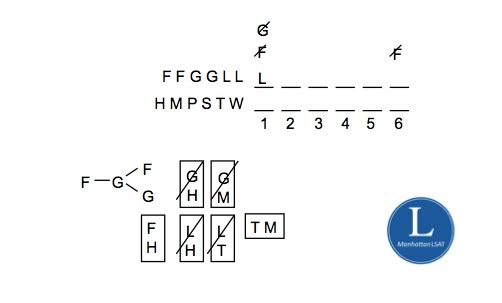
LSAT Forum
11 postsPage 1 of 1
-

- cdjmarmon
-
Thanks Received: 0
-
Elle Woods

- Posts: 59
- Joined: July 12th, 2011
Re: Diagram
Im a little confused why the first rule doesn't translate to:
F-G-G-F
To me thats what "Frank demonstrates exactly one task before Gladys demonstrates any of the tasks" would be.
Can anyone clarify that?
F-G-G-F
To me thats what "Frank demonstrates exactly one task before Gladys demonstrates any of the tasks" would be.
Can anyone clarify that?
-

- ManhattanPrepLSAT1
-
Thanks Received: 1909
-
Atticus Finch

- Posts: 2851
- Joined: October 07th, 2009
- This post thanked 1 time.
Re: Diagram
Both of the following two possibilities have Frank demonstrating exactly one task before Gladys demonstrates any of the tasks.
F - G - G - F
F - G - F - G
It is not possible, however, for Gladys to demonstrate a task before either task demonstrated by Frank, such as the following three possibilities.
G - F - F - G
G - F - G - F
G - G - F - F
It is also not possible for Frank to demonstrate two tasks before Gladys demonstrates any, as in the following possibility.
F - F - G - G
Hope that helps!
F - G - G - F
F - G - F - G
It is not possible, however, for Gladys to demonstrate a task before either task demonstrated by Frank, such as the following three possibilities.
G - F - F - G
G - F - G - F
G - G - F - F
It is also not possible for Frank to demonstrate two tasks before Gladys demonstrates any, as in the following possibility.
F - F - G - G
Hope that helps!
-

- cdjmarmon
-
Thanks Received: 0
-
Elle Woods

- Posts: 59
- Joined: July 12th, 2011
Re: Diagram
It does help a little seeing both possibilities. Thank you.
Its just the "any" part that I interpret as "both" or "all." I see it as Frank demonstrates exactly one task before Gladys demonstrates both or all of her tasks".
So, I see the only possibility being F-G-G-F. Becuase F-G-F-G would be F demonstrating 2 tasks before G.
Its just the "any" part that I interpret as "both" or "all." I see it as Frank demonstrates exactly one task before Gladys demonstrates both or all of her tasks".
So, I see the only possibility being F-G-G-F. Becuase F-G-F-G would be F demonstrating 2 tasks before G.
-

- rfojas11
-
Thanks Received: 0
-
Vinny Gambini

- Posts: 11
- Joined: June 11th, 2012
Re: Diagram
I'm a little confused as to how we know that Frank must do the harvesting demonstration. Do we know this from process of elimination from Gladys' and Leslie's constraints?
Thank you.
Thank you.
-

- mitrakhanom1
-
Thanks Received: 1
-
Elle Woods

- Posts: 63
- Joined: May 14th, 2013
Re: Diagram
I'm confused as to why there is an L on spot 1? How did you get F above H? I still don't understand why its the F-G-G-F combination is valid? Please help. Thanks.
-

- ohthatpatrick
-
Thanks Received: 3808
-
Atticus Finch

- Posts: 4661
- Joined: April 01st, 2011
Re: Diagram
Good questions.
F has to do harvesting because rule 3 says that G can't do harvesting and rule 4 says that L can't do harvesting.
SOMEONE has to do harvesting. There are only three people: F, G, and L. So by process of elimination you get that F is doing harvesting.
L has to go first, also through process of elimination.
F can't go first (or last) because of rule 2.
G can't go first because of rule 1.
So if F and G can't go 1st, then L will have to go 1st.
In terms of interpreting the language of that 1st rule, it is only trying to guarantee that we have exactly one F before we get our first G.
If we had
G - G - F - F
G - F - G - F
or
G - F - F - G
then Frank would be demonstrating exactly NO tasks before Gladys demonstrates any.
If we had
F - F - G - G
then Frank would be demonstrating exactly TWO tasks before Gladys demonstrates any.
If we had
F - G - F - G
or
F - G - G - F
then Frank is demonstrating exactly ONE task before Gladys demonstrates any.
The 'any' here is basically saying "Frank has to do exactly one thing before Gladys starts doing anything".
I think people are getting confused about it because they're thinking that it says, "Frank does exactly one before Gladys does ALL of her tasks".
This confusion is probably due to the fact that in some contexts, any and all mean the same thing.
Any square is a rectangle
and
All squares are rectangles
essentially mean the same thing.
But consider the difference in meaning between these two sentences:
"I'd be happy with any of my friends sharing a dorm room with me"
vs.
"I'd be happy with all of my friends sharing a dorm room with me"
Here, they mean different things.
"Any of my friends" means you could pick ANY ONE of my friends to live with me and I'd be happy.
"All of my friends" means that I would be happy living with the ENTIRE GROUP of my friends.
(If you wanna get real technical, 'any' and 'all' act the same as adjectives, but they act differently here as nouns)
Hope this clarifies. Let us know otherwise.
F has to do harvesting because rule 3 says that G can't do harvesting and rule 4 says that L can't do harvesting.
SOMEONE has to do harvesting. There are only three people: F, G, and L. So by process of elimination you get that F is doing harvesting.
L has to go first, also through process of elimination.
F can't go first (or last) because of rule 2.
G can't go first because of rule 1.
So if F and G can't go 1st, then L will have to go 1st.
In terms of interpreting the language of that 1st rule, it is only trying to guarantee that we have exactly one F before we get our first G.
If we had
G - G - F - F
G - F - G - F
or
G - F - F - G
then Frank would be demonstrating exactly NO tasks before Gladys demonstrates any.
If we had
F - F - G - G
then Frank would be demonstrating exactly TWO tasks before Gladys demonstrates any.
If we had
F - G - F - G
or
F - G - G - F
then Frank is demonstrating exactly ONE task before Gladys demonstrates any.
The 'any' here is basically saying "Frank has to do exactly one thing before Gladys starts doing anything".
I think people are getting confused about it because they're thinking that it says, "Frank does exactly one before Gladys does ALL of her tasks".
This confusion is probably due to the fact that in some contexts, any and all mean the same thing.
Any square is a rectangle
and
All squares are rectangles
essentially mean the same thing.
But consider the difference in meaning between these two sentences:
"I'd be happy with any of my friends sharing a dorm room with me"
vs.
"I'd be happy with all of my friends sharing a dorm room with me"
Here, they mean different things.
"Any of my friends" means you could pick ANY ONE of my friends to live with me and I'd be happy.
"All of my friends" means that I would be happy living with the ENTIRE GROUP of my friends.
(If you wanna get real technical, 'any' and 'all' act the same as adjectives, but they act differently here as nouns)
Hope this clarifies. Let us know otherwise.
-

- gabrielchammas
-
Thanks Received: 0
-
Vinny Gambini

- Posts: 2
- Joined: July 11th, 2013
Re: Diagram
For the first rule Frank demonstrates exactly one task before Glads demonstrates any of the tasks.
From the previous threads it seems that the interpretation is stating that Frank must be in front of all G's task. But the way that i interpreted it is that at least ONE of Franks task must be before Glad performs any task not that ALL of franks task must be in front of all necessarily ALL G's ask.
I did not grasp that concept, can someone explain?
From the previous threads it seems that the interpretation is stating that Frank must be in front of all G's task. But the way that i interpreted it is that at least ONE of Franks task must be before Glad performs any task not that ALL of franks task must be in front of all necessarily ALL G's ask.
I did not grasp that concept, can someone explain?
-

- maryadkins
-
Thanks Received: 641
-
Atticus Finch

- Posts: 1261
- Joined: March 23rd, 2011
Re: Diagram
You're right. Frank does ONE before Gladys does any. Frank does NOT do all of his before she does any (because then he'd be doing more than one).
So it's:
F1 comes first
Then G1
Then after that, it doesn't matter how F2 and G2 are ordered.
So it's:
F1 comes first
Then G1
Then after that, it doesn't matter how F2 and G2 are ordered.
-

- keonheecho
-
Thanks Received: 0
-
Elle Woods

- Posts: 54
- Joined: August 20th, 2014
Re: Diagram
ohthatpatrick Wrote:Good questions.
F has to do harvesting because rule 3 says that G can't do harvesting and rule 4 says that L can't do harvesting.
SOMEONE has to do harvesting. There are only three people: F, G, and L. So by process of elimination you get that F is doing harvesting.
L has to go first, also through process of elimination.
F can't go first (or last) because of rule 2.
G can't go first because of rule 1.
So if F and G can't go 1st, then L will have to go 1st.
In terms of interpreting the language of that 1st rule, it is only trying to guarantee that we have exactly one F before we get our first G.
If we had
G - G - F - F
G - F - G - F
or
G - F - F - G
then Frank would be demonstrating exactly NO tasks before Gladys demonstrates any.
If we had
F - F - G - G
then Frank would be demonstrating exactly TWO tasks before Gladys demonstrates any.
If we had
F - G - F - G
or
F - G - G - F
then Frank is demonstrating exactly ONE task before Gladys demonstrates any.
The 'any' here is basically saying "Frank has to do exactly one thing before Gladys starts doing anything".
I think people are getting confused about it because they're thinking that it says, "Frank does exactly one before Gladys does ALL of her tasks".
This confusion is probably due to the fact that in some contexts, any and all mean the same thing.
Any square is a rectangle
and
All squares are rectangles
essentially mean the same thing.
But consider the difference in meaning between these two sentences:
"I'd be happy with any of my friends sharing a dorm room with me"
vs.
"I'd be happy with all of my friends sharing a dorm room with me"
Here, they mean different things.
"Any of my friends" means you could pick ANY ONE of my friends to live with me and I'd be happy.
"All of my friends" means that I would be happy living with the ENTIRE GROUP of my friends.
(If you wanna get real technical, 'any' and 'all' act the same as adjectives, but they act differently here as nouns)
Hope this clarifies. Let us know otherwise.
Hi Patrick,
I see what you mean by the difference between any and all. But on the LSAT, isn't it the case that any is intended indicate a sufficient condition, and in that case doesn't it mean the same as all? And if not, how do we know which application of the term we are to use? Also, are there any other games that have this type of rule that you know of for extra practice? Thank you in advance
-

- tommywallach
-
Thanks Received: 468
-
Atticus Finch

- Posts: 1041
- Joined: August 11th, 2009
Re: Diagram
Hey Keon,
Neither word is specific to the situation you're mentioning, so the answer is no: the word any does not have some particular attachment to sufficient conditions. It can also be used for necessary (i.e. "Any person without a degree will fail to be hired by Company C."). And I don't know of specific games that test the same language, but keep practicing. If they're out there, you'll find them. If they aren't...well then the logic still applies.
-t
Neither word is specific to the situation you're mentioning, so the answer is no: the word any does not have some particular attachment to sufficient conditions. It can also be used for necessary (i.e. "Any person without a degree will fail to be hired by Company C."). And I don't know of specific games that test the same language, but keep practicing. If they're out there, you'll find them. If they aren't...well then the logic still applies.
-t
11 posts Page 1 of 1
